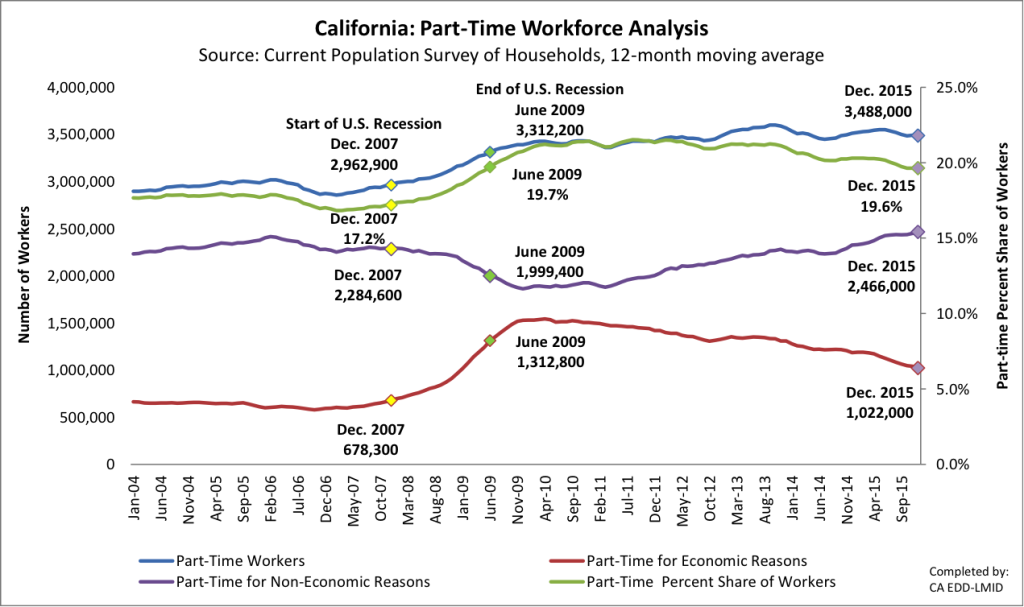 Over the past few years, a main storyline in California employment has been the shift from full-time employment with expectations of stability to employment that is contingent (for limited period or project-based), or independent-contracting, or part-time (particularly part-time without benefits), or a combination of these elements. Part-time employment growth has been the easiest to track, since the federal and state governments maintain monthly data on part-time versus full-time employment. So, as we move into 2016, it is time to revisit the data.
Over the past few years, a main storyline in California employment has been the shift from full-time employment with expectations of stability to employment that is contingent (for limited period or project-based), or independent-contracting, or part-time (particularly part-time without benefits), or a combination of these elements. Part-time employment growth has been the easiest to track, since the federal and state governments maintain monthly data on part-time versus full-time employment. So, as we move into 2016, it is time to revisit the data.
Once again with California data, we start with the Labor Market Information Division (LMID) of the state Employment Development Department. LMID analyst Brandon Hooker, who has been tracking part-time employment , points us to the graph above (click to enlarge), which shows the growth of part-time employment overall, and its two main forms “Part time for economic reasons”, and “Part time for non-economic reasons”. He points us to a companion chart (below), showing the change in part-time employment in two-year intervals since December 2005.
What do the data show? First, part-time employment is a significant part of employment in California, up to nearly 20% of the California workforce. It grew from 17.7% of the workforce in December 2005 to over 21% in December 2011 during the Great Recession. It has gone down since December 2011, but at December 2015 was well-above pre-Great Recession levels.
The definition of part time employment includes all workers who are employed less than 35 hours per week. Among these workers are some who are employed thirty hours or more, and others who may work ten hours a week or less. Overall, part time employment, stood at 3,488,000 workers in December 2015. All of these workers were counted as employed for the unemployment rate, and their jobs, even if a few hours a week, were counted among the payroll employment numbers in California.
One of the two sub-groups of the part-time employed is the “Part-time for economic reasons” workers: workers who are working part-time but say that they seek full-time work. The number of these workers has shot up since December 2005. At that time, these workers totaled 609,100 in California. During the Great Recession they reached a high of 1,528,000, and by December 2015 were at 1,022,000, well above pre-Great Recession levels. The other group, “Part time for non-economic reasons” say to interviewers that they prefer part-time work (for family obligations, school, or other reasons). They have grown since December 2005, but far more slowly, constituting 2,378,400 workers in December 2005 and 2,466,000 workers in December 2015.
Mr. Hooker describes the changes in part-time employment in California since 2005, as due to both cyclical and structural trends. “During a recessionary business cycle, there are fewer full time opportunities for job seekers as firms restructure to deal with downturns in consumer demand and the global economy”, he writes. “This opens the door to more part-time opportunities for job seekers.” However, even as the economy has improved since December 2011, the part-time employment has not reverted to pre-Great Recession levels, due to structural changes, pushing employers away from full-time employment with benefits.
What does this growth of part-time employment, especially involuntary part-time employment, mean for 2016? The growth, especially in involuntary part-time employment, is likely not only to continue but accelerate. The economy is now in its seventh year of employment growth, longer than previous post-recession recoveries, and a downturn may spur a movement toward restructuring. Added to this are the other forces today pushing away from full-time employment, ranging from the added costs and liabilities to employers of taking on full-time employees, the growth of the on-demand services like Uber, and the rising “taskification” of jobs. We need to continue to track this important employment indicator.


